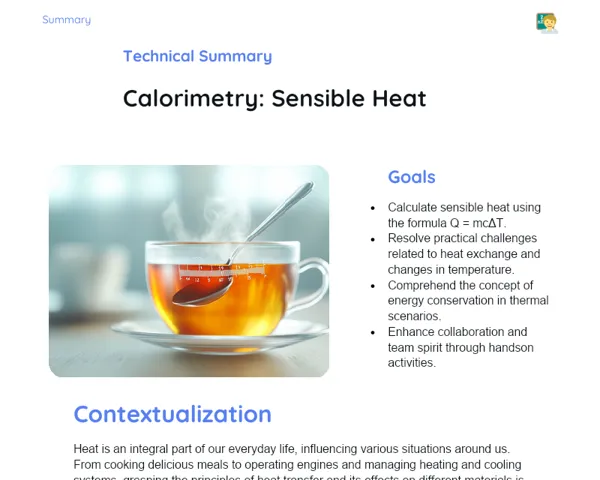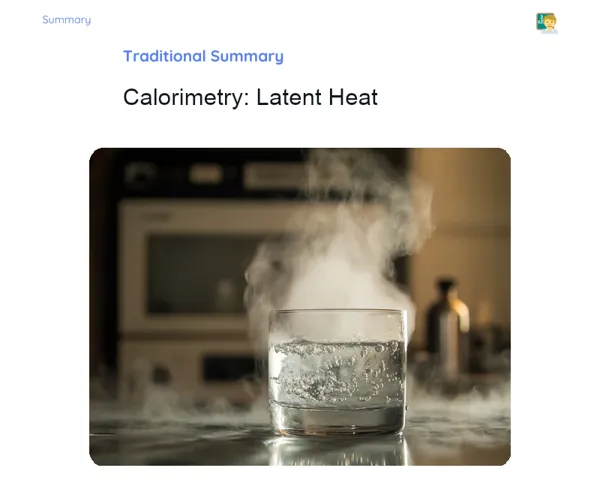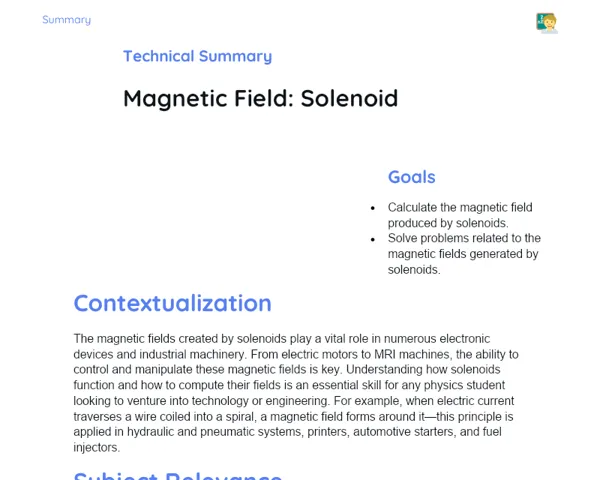Summary Tradisional | Thermodynamics: Internal Energy of a Gas
Contextualization
Thermodynamics, as many of us know, is a branch of physics that delves into the interplay of heat, work, and energy. A key idea here is the internal energy of a gas – essentially the total energy held by the gas molecules. This energy is split into kinetic energy, which comes from the movement of the molecules, and potential energy, linked to the forces acting between them. In the case of ideal gases, the internal energy is determined entirely by the temperature, which simplifies both calculations and our overall understanding of these processes.
Consider a simple example: imagine a helium balloon. When you heat it, the gas inside expands because its internal energy increases. This principle is not just academic – it underpins everyday systems, from the workings of internal combustion engines to the air-conditioning systems in our homes and offices. Grasping how internal energy varies with temperature and other properties is vital for developing more efficient and eco-friendly technologies.
To Remember!
Concept of Internal Energy
Think of the internal energy of a gas as the sum total of the kinetic and potential energies of its molecules. For an ideal gas, we assume that the internal energy depends only on its temperature. The average kinetic energy, which scales with temperature, is the main player – the higher the temperature, the more energetic the molecules become, thereby increasing the internal energy.
Since ideal gases assume no significant intermolecular forces, the potential energy part is taken as zero. Therefore, in our calculations, we're essentially looking at the kinetic energy determined solely by temperature.
This concept is pivotal when analysing various processes like heating, cooling, or even phase changes because it lays the foundation for understanding energy transfer in the form of heat or work.
-
The internal energy of a gas is the sum of the kinetic and potential energies of its molecules.
-
In ideal gases, internal energy depends only on temperature.
-
The average kinetic energy directly correlates with temperature.
First Law of Thermodynamics
Commonly known as the Law of Conservation of Energy, the First Law of Thermodynamics tells us that the total energy within an isolated system remains constant. Mathematically, it is often expressed as ΔU = Q - W, where ΔU is the change in internal energy, Q represents the heat added, and W is the work done by the system.
What this means in practical terms is that if a system absorbs heat or has work done on it, its internal energy increases; conversely, if it does work or loses heat, its internal energy drops.
This law is fundamental when examining energy transfers in everyday systems such as refrigerators, air conditioners, or even the cycles in heat engines.
-
The First Law of Thermodynamics is basically the Law of Conservation of Energy.
-
It is represented by ΔU = Q - W.
-
Internal energy rises with added heat or work on the system, and falls when the system does work or loses heat.
Calculation of Internal Energy
To compute the internal energy of an ideal gas, we use the formula U = (3/2) nRT, where n is the number of moles of the gas, R stands for the gas constant (8.31 J/mol·K), and T is the temperature in Kelvin. The basis of this formula is the dependency of internal energy solely on the temperature and the amount of gas present.
Remember, while working with this formula, always convert the temperature into Kelvin to avoid any errors in calculation. This equation comes in particularly handy when dealing with isochoric processes (where the volume remains constant) and understanding energy changes.
Using this formula, we can determine the internal energy under various conditions, which is essential for analysing systems like heaters, coolers, and other thermal devices.
-
The internal energy of an ideal gas is calculated using U = (3/2) nRT.
-
R is the gas constant valued at 8.31 J/mol·K.
-
Always ensure the temperature is in Kelvin for accurate results.
Practical Examples
Let’s bring the theory to life with some practical examples. Consider a cylinder that contains 2 moles of an ideal gas at 300 K. By applying the formula U = (3/2) nRT, we substitute the values to get U = (3/2) * 2 * 8.31 * 300, which gives us an internal energy of 4986 J.
Another scenario: if 500 J of heat is added to a system while it performs 200 J of work, the change in internal energy will be ΔU = 500 - 200, resulting in ΔU = 300 J.
Yet another example might involve an ideal gas whose internal energy increases by 900 J without doing any work. Here, by the first law, since W = 0, we find that Q equals ΔU, meaning 900 J of heat is added. These examples put theory into context and make it easier for students to see how these principles work in real-life situations.
-
Calculating internal energy: U = (3/2) * 2 * 8.31 * 300 = 4986 J.
-
For heat and work changes: ΔU = 500 - 200 = 300 J.
-
When no work is done: the heat added is Q = 900 J.
Key Terms
-
Internal Energy: The total of kinetic and potential energies of the gas molecules.
-
Ideal Gas: A theoretical gas where interactions between molecules are negligible, and its internal energy depends solely on temperature.
-
First Law of Thermodynamics: States that the total energy in an isolated system is constant, expressed as ΔU = Q - W.
-
Heat (Q): Energy transferred as a result of temperature differences.
-
Work (W): Energy transferred when a force causes movement.
-
Gas Constant (R): A constant value, 8.31 J/mol·K, used in calculating internal energy.
-
Temperature (T): A measure of the average kinetic energy of the gas molecules.
Important Conclusions
In this lesson, we delved into the internal energy of a gas – a cornerstone concept in thermodynamics representing the sum of kinetic and potential energies of gas molecules. We explored how, in ideal gases, internal energy is completely dependent on temperature, which made it possible to calculate it neatly using U = (3/2) nRT, factoring in the gas constant R and the temperature in Kelvin. We also examined the First Law of Thermodynamics, which links changes in internal energy with heat added and work done by the system, as expressed in ΔU = Q - W.
This topic is particularly relevant as we see its applications in everyday items, from the workings of internal combustion engines to the air-conditioning systems that keep our workspaces comfortable. The practical examples covered in class have helped illustrate these concepts, highlighting how theory really translates into practice.
I encourage you to further explore these ideas because thermodynamics not only deepens our understanding of physical processes but also paves the way for advancements in technology. Keep studying, experimenting, and sharing these insights with your students as you build a strong foundation for future innovations.
Study Tips
-
Revisit the fundamental concepts of thermodynamics – heat, work, and internal energy – to reinforce your understanding.
-
Practice solving numerical problems using formulas like U = (3/2) nRT and ΔU = Q - W to boost your confidence.
-
Look into other resources, including educational videos and scientific articles, for a broader perspective on the internal energy of gases and their real-world applications.



